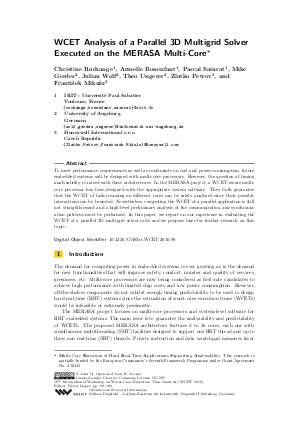WCET Analysis of a Parallel 3D Multigrid Solver Executed on the MERASA Multi-Core
Authors Christine Rochange, Armelle Bonenfant, Pascal Sainrat, Mike Gerdes, Julian Wolf, Theo Ungerer, Zlatko Petrov, Frantisek Mikulu
-
Part of:
Volume:
10th International Workshop on Worst-Case Execution Time Analysis (WCET 2010)
Part of: Series: Open Access Series in Informatics (OASIcs)
Part of: Conference: Workshop on Worst-Case Execution Time Analysis (WCET) - License:
 Creative Commons Attribution-NonCommercial-NoDerivs 3.0 Unported license
Creative Commons Attribution-NonCommercial-NoDerivs 3.0 Unported license
- Publication Date: 2010-11-26
File

PDF
OASIcs.WCET.2010.90.pdf
- Filesize: 0.66 MB
- 11 pages
Document Identifiers
Subject Classification
Keywords
- WCET analysis
- multicore
- timing predictability
Metrics
- Access Statistics
-
Total Accesses (updated on a weekly basis)
0PDF Downloads0Metadata Views
Abstract
To meet performance requirements as well as constraints on cost and power consumption, future embedded systems will be designed with multi-core processors. However, the question of timing analysability is raised with these architectures. In the MERASA project, a WCET-aware multi-core processor has been designed with the appropriate system software. They both guarantee that the WCET of tasks running on different cores can be safely analyzed since their possible interactions can be bounded. Nevertheless, computing the WCET of a parallel application is still not straightforward and a high-level preliminary analysis of the communication and synchronization patterns must be performed. In this paper, we report on our experience in evaluating the WCET of a parallel 3D multigrid solver code and we propose lines for further research on this topic.
Cite As Get BibTex
Christine Rochange, Armelle Bonenfant, Pascal Sainrat, Mike Gerdes, Julian Wolf, Theo Ungerer, Zlatko Petrov, and Frantisek Mikulu. WCET Analysis of a Parallel 3D Multigrid Solver Executed on the MERASA Multi-Core. In 10th International Workshop on Worst-Case Execution Time Analysis (WCET 2010). Open Access Series in Informatics (OASIcs), Volume 15, pp. 90-100, Schloss Dagstuhl – Leibniz-Zentrum für Informatik (2010)
https://doi.org/10.4230/OASIcs.WCET.2010.90
BibTex
@InProceedings{rochange_et_al:OASIcs.WCET.2010.90,
author = {Rochange, Christine and Bonenfant, Armelle and Sainrat, Pascal and Gerdes, Mike and Wolf, Julian and Ungerer, Theo and Petrov, Zlatko and Mikulu, Frantisek},
title = {{WCET Analysis of a Parallel 3D Multigrid Solver Executed on the MERASA Multi-Core}},
booktitle = {10th International Workshop on Worst-Case Execution Time Analysis (WCET 2010)},
pages = {90--100},
series = {Open Access Series in Informatics (OASIcs)},
ISBN = {978-3-939897-21-7},
ISSN = {2190-6807},
year = {2010},
volume = {15},
editor = {Lisper, Bj\"{o}rn},
publisher = {Schloss Dagstuhl -- Leibniz-Zentrum f{\"u}r Informatik},
address = {Dagstuhl, Germany},
URL = {https://drops.dagstuhl.de/entities/document/10.4230/OASIcs.WCET.2010.90},
URN = {urn:nbn:de:0030-drops-28298},
doi = {10.4230/OASIcs.WCET.2010.90},
annote = {Keywords: WCET analysis, multicore, timing predictability}
}
